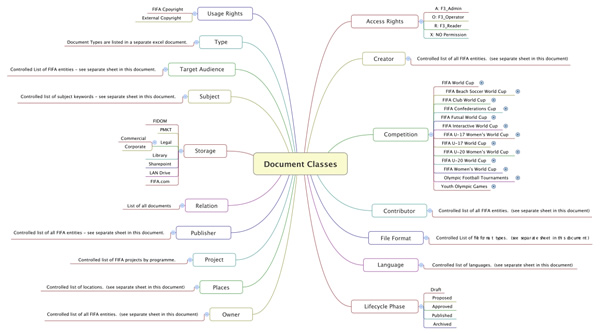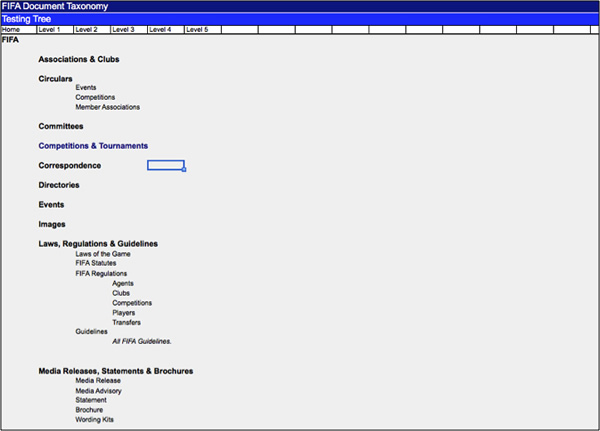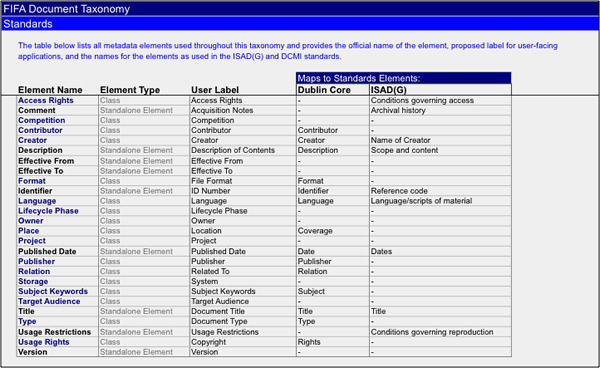Football’s governing body, FIFA, required a set of classifications and definitions for the official documents they’ve created – all 70,000 of them.
Over the course of 6 months Adam Ungstad worked with stakeholders from across this dynamic organization to build consensus on a set of terms, classes, hierarchy and definitions that describe the content they produce.
The final result was a detailed taxonomy that meets international standards including ISAD(G) and Dublin Core. The implementation of this taxonomy of FIFA’s official documents will enable the organization to better find, manage and publish their official documents across internal and external channels.
Here’s a quick look at some of the highlights from the project:
Document Types & Classes

Excerpt of document classes.
From a bird’s eye perspective, the taxonomy created by Adam Ungstad can be split into three primary areas: Document Types, Document Classes, and other metadata attributes.
The final taxonomy provides specifications for over 250 document types, such as “Manual” or “Circular”, over 600 document classes, such as “Project” or “Place”, as well as a handful of other metadata attributes such as “Identifier” needed to find and manage documents.
This detailed taxonomy was presented in excel form, with supporting diagrams providing an at-a-glance overview of the first two levels of each hierarchy.
Navigation Tree

Excerpt of the navigation tree.
Having a hierarchy of properly labelled and organized classes is one thing, but from a navigation standpoint simply presenting the entire comprehensive taxonomy to end users is often not the best solution. While a taxonomy may need 600 classes to enable queries for publishing purposes, this amount of classes is often an overload for a user navigating a hierarchy from the top to find a single item at the bottom.
Adam Ungstad worked with users at FIFA to conduct several iterations of online tree-testing to see how users would expect to find documents within the taxonomy if it was presented as a folder tree. After testing different variations of the hierarchy Ungstad was able to create a modified version of the taxonomy that can be used for the purpose of navigation, either as a folder tree or within an intranet site.
Standards Map

Excerpt of a map created to show links between the final taxonomy and existing international standards.
When creating a new enterprise standard such as a taxonomy it is always preferable to borrow or re-use from existing international standards in the industry (that’s what they are there for). Yet the catch is that you will never find a single standard that meets all of a given organization’s needs, or one that is useful to all stakeholders.
The approach taken by Adam Ungstad on this project was to identify which standards were closest to the needs of FIFA, and to provide maps between the standards and the new taxonomy. In this case FIFA identified the International Standard Archival Description (General) framework as a requirement from an archiving perspective, and Ungstad proposed the use of basic elements from the well-known Dublin Core standard.
During the testing phases of the project we found that users found some of the labels used in the standards a bit vague (such as “Coverage”), and so while the elements in the taxonomy are the same from a semantic perspective, in some cases we chose to use labels that were more meaningful to users (such as “Location” instead of “Coverage”). Ungstad provided a standards map with the final taxonomy to show how the standards are used, and where labels were changed for FIFA’s taxonomy.
Final Report

Cover page & table of contents for the final report.
An enterprise taxonomy is a critical starting point to being able to manage content consistently across an organization. Yet there are many more factors that need to be considered before the taxonomy can be used effectively.
Questions around enterprise workflow need to be answered, and decisions need to be made on how to actually store metadata associated with a collection. Throughout this project Ungstad engaged with stakeholders from across the organization to prepare a 75 page report with diagrams and recommendations on:
- Document Lifecycle
- Document Workflow
- Document Quality Control
- Implementing the taxonomy
- Protocol for naming and versioning
- Storing metadata for documents
- Metadata Governance
- Extending the taxonomy
Adam Ungstad used a range of information architecture methods including user research, interactive workshops, card-sorting, tree-testing, and industry analysis to develop this taxonomy with FIFA. You can also read about a useful exercise we did in the project kick-off workshop called Metadata Dot-Mocracy.
Work samples and references from this project are available on request. For further information please contact Adam Ungstad at info@ungstad.com.
